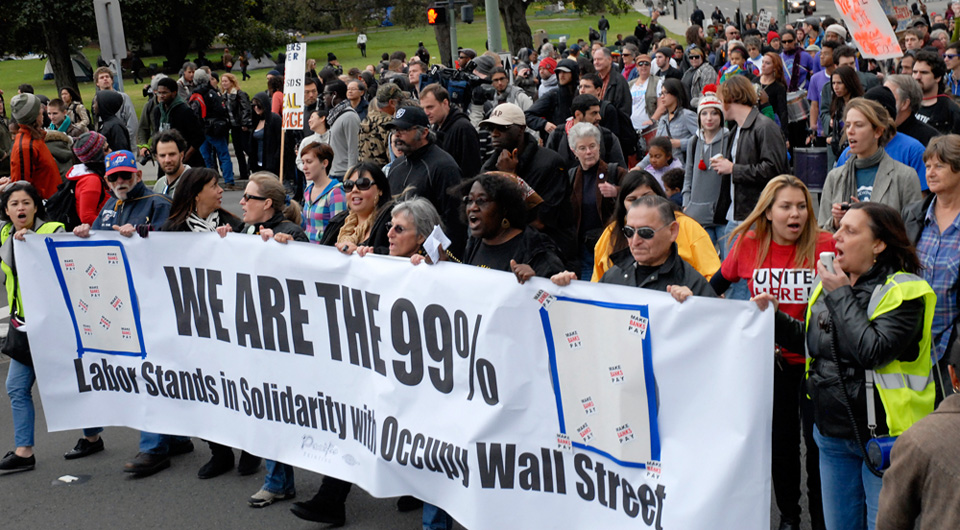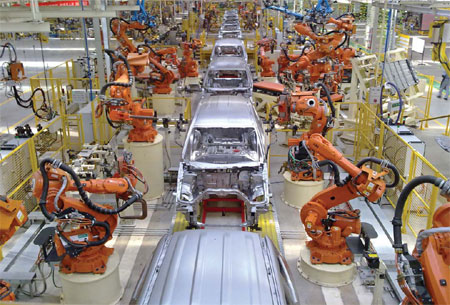
This article is based on remarks made by the author at the CPUSA National Labor Conference, May 20-21, in Chicago.
Several crises of contemporary capitalism have reached or are reaching dangerous tipping points. They are rooted in a path of destructive and unsustainable development.
They include extreme wealth and social inequality, job loss and dislocation from automation, and the existential threat posed by the ecological crisis.
These interconnected crises are impacting everything and must be addressed together. And they can be.
But standing in the way are Trump, the GOP and extreme right, and their main support base: monopoly-finance capital, the fossil fuel industry, and the military-industrial complex. Their agenda is intensifying these crises and must be defeated.
This underscores the urgency to build the broadest resistance movement and radically elevate the fight for unity of our multi-racial, male-female, LGBTQ, immigrant and native-born working class and people. This is central to guarantee the working class emerges as leader of the entire movement to break the extreme right political stranglehold and open the way for the challenging, contested, and complex transition to a just, peaceful, eco-socialist society.
Planetary emergency
Fossil fuels have been the main energy source of capitalism since industrialization and a prime source of profits. Along with the drive for infinite economic growth on a finite planet, this makes capitalism inherently hostile to the Earth’s ecology.
“The rapidity with which the human-caused positive [climate] forcing is being introduced has no known analog in Earth’s history. It is thus exceedingly difficult to foresee the consequences if the human-made climate forcing continues to accelerate,” say climate scientists James Hansen and Makiko Sato.
The existential threat facing Earth must be addressed now. But even with radical measures, the damage is already immense and will take generations to reverse.
Capitalist market forces are leading to the liquidation of the coal industry in favor of natural gas, solar, wind, and geothermal – all of which are cheaper and a new source of profits. This is happening more rapidly than previously estimated. The solar industry already employs twice as many workers as the coal industry.
But capitalism, an inherently wasteful system, is incapable of fully shedding fossil fuels, the massively inefficient and polluting car culture, and other practices. A central condition of any socialist transition is the complete elimination of fossil fuels as an energy source.
The “just transition” to clean energy, demilitarization, and a universal health care system will cause massive employment dislocation. However, transitioning to renewable energy, retrofitting for energy conservation, and building a modern infrastructure that also adapts to rising sea levels and extreme weather events and expanding public healthcare, education, and culture will create of millions of new jobs.
Crisis of extreme wealth concentration
Monopolization, or more accurately, the formation of oligopolies, and extreme wealth concentration is accelerating. Capitalism, whose only reason for existence is to maximize profits, is incapable of reversing this process.
The world’s eight richest people own wealth equal to the poorest half of the world’s population. In the U.S., the top 1 percent own 35 percent of all wealth and the bottom 80 percent own just 7 percent of the nation’s wealth.
We’re really talking about the top .1 percent – an oligarchy.
Extreme wealth concentration is accompanied by a tendency toward permanent stagnation. U.S. capitalist growth rates have declined from 3.5 percent in the 1960s to 1 percent in the 2000s, although growth picked up after the Great Recession.
Wealth concentration, wage suppression and attacks on organized labor and interconnected. Despite rising productivity, wages have been flat or declined the past 40 years. Income inequality based on race and gender is growing.
The introduction of neoliberal policies in the 1970s was an attempt by capitalists to overcome declining growth and profit rates by removing obstacles to maximizing profits – including globalized production, privatization, and elimination of labor, health, and environmental protections. Every crisis of capitalism has been aggravated, including extreme levels of wealth concentration and the ecological emergency.
Financial speculation is another feature of contemporary capitalism. With declining growth rates, external economic stimulus is necessary in the form of consumer credit to create demand. The results are credit “bubbles” and mammoth consumer debt. These bubbles inevitably burst, like the 2008 “housing bubble,” resulting in devastating crises.
Consumer debt, including for students and auto loans, is reaching pre-2008 levels.
Any large-scale infrastructure works and green transition will require massive wealth redistribution, including substantial wage increases, immense public investment, and reorienting federal budget priorities.
Trade, automation, and job loss
A debate is taking place over whether unemployment due to automation – and specifically robots – distinct from cyclical and structural unemployment, is growing. Many are warning of massive job losses from accelerating introduction of robots, although a new EPI report challenges this idea.

Capitalism is marked by the constant revolutionizing of the means of production. In 1800, the agricultural labor force made up 80 percent of total employment in the U.S. Today it is less than 2 percent. In 1960, the manufacturing sector made up 25 percent of total employment. In 2014, it was 8.8 percent.
The revolution based on digital technology has facilitated capitalist globalization, increased productivity, and economic dislocation.
Global supply chains, just-in-time production, the gig economy, and the shift to the service sector increasingly characterize present-day capitalism.
Approximately 40 percent of the workforce is composed of contingent workers, i.e. temp agencies, on-call, contract workers, independent contractors, the self-employed, and involuntary part-time (6.6 million).
Unfair trade agreements, shifting transnational corporate investments, and outsourcing to global low-wage zones have harshly impacted U.S. manufacturing employment.
It is estimated NAFTA resulted in the loss of 1 million jobs in the U.S. and another 1.3 million among Mexican farmers, precipitating the surge in immigration. Approximately 1 million jobs were lost from transnational corporate outsourcing to China between 2000-2007, after it joined the World Trade Organization (WTO).
This was offset by domestic job creation mainly in the low-wage service sector. More than 80 percent of private sector employment is now in service jobs.
These trade pacts have driven a race to the bottom in wages, health and safety, and environmental protections. U.S., Mexican, and Canadian workers have all suffered.
These agreements should be renegotiated to impose global standards for wages, labor, health and safety, and environmental protections, and restore national sovereignty and the authority of democratic institutions.
But unfair free trade pacts don’t tell the entire story. Obscured in all this, including by Trump’s economic nationalism, right-wing populism, and racist scapegoating, is the ongoing impact of automation.
In the past 20 years, a span that includes NAFTA and China’s entrance into the WTO, U.S. manufacturing output has increased 40 percent. U.S. workers are being exploited more than ever.
“America has lost more than 7 million factory jobs since manufacturing employment peaked in 1979. Yet American factory production…more than doubled over the same span…(in 2015),” reported the New Haven Register.
“(A Ball State study)…found that trade accounted for just 13 percent of America’s lost factory jobs. The vast majority of the lost jobs – 88 percent – were taken by robots and other homegrown factors that reduce…labor.”
The Obama Administration projected 47 percent of U.S. jobs would be at risk of elimination due to automation by 2025.
If these forecasts are accurate, automation will create economic dislocation and loss of jobs on a scale not seen before, including 5.1 million over the next five years.
Over the next decade, it is estimated 1.7 million trucker jobs will be eliminated. Sales, customer service, transportation, medical/ healthcare, and the legal fields will be most impacted.
Loss of coal mining jobs is not due to a “war on coal,” as Trump would have us believe, but rather to lower natural gas prices and greater automation. Between 1980 and 2015, the coal industry shed 59 percent of mining jobs but production grew 8 percent.
New technology and modern production methods are responsible for major job losses in the steel and metals industry. Since 1997, 42 percent of jobs have been eliminated while production grew 38 percent.
The construction trades won’t escape automation, either. A union pipefitter friend told me about new technology that eliminates pipe welders. Five hundred thousand construction jobs will be lost in the next five years due to automation.
Some outsourced industries are beginning to return to the U.S., like the textile industry. But they are globally competitive on the basis of automation, not wages.
In the past, technological advances have decimated employment in some industries but given rise to employment in new ones, changing the composition of the workforce.
What’s different this time, according to some observers, is artificial intelligence, which is being applied to visual and voice recognition. Computers can now “think and learn” without humans. Factories already exist where production never touches human hands.
While automation creates crises for capitalism, it also creates the material conditions for socialism, a society based on putting the needs of people first.
Permanent underemployment
Long-term unemployment is growing. The official unemployment rate is under 5 percent, but the non-participation rate is now close to 40 percent. Nearly 95 million Americans don’t participate in the production process.
Average monthly job growth is not keeping up with population growth. One estimate claims that one-third of men aged 25-54 will be out of work by 2050.
Unemployment carries a racist edge as well and is nearly generational among African American, Latino, and Native American youth. Areas of deep poverty also exist among whites in rural regions.
Clearly, long-term joblessness is a growing crisis for capitalism and is being exacerbated by globalization, wage suppression and automation.
Expanding democracy for a sustainable transition and modern infrastructure
Any massive and rapid change in structural employment is fertile soil for extreme right-wing demagogues. This danger can be addressed by advocating a bold vision for economic and social security inclusive of all workers and their communities.
Any proposal to rebuild the nation’s infrastructure will be an arena of mass struggle, with competing class and social interests.
Trump’s infrastructure proposal is geared to repairing a 20th century infrastructure based on fossil fuels and enriching wealthy contractors and investors. He is banking on the working class footing the bill while splitting labor to build a loyal base among the building trades.
The American Society of Civil Engineers has called for a $2 trillion project. The AFL-CIO supported Trump’s original call for a $1 trillion investment, with certain conditions.
Broad-based unity can be built around a modern infrastructure act and a just transition to a sustainable economy that will create millions of jobs with union wages and protections, address social inequality, and restore and expand basic democratic rights.
Demands arising from the Fight for $15, racial justice, climate justice, reproductive justice, LGBTQ, immigrant rights, and other mass movements are forming the programmatic basis for unity.
Intersectionality and solidarity is growing between movements in the current upsurge against Trump. For example, the jobs and environmental crises are being interlinked and addressed by the Blue-Green Alliance and the Labor Network for Sustainability, environmental justice, civil rights, and other movements.
This is the basis to unite our multi-racial working class, overcome current divisions within labor and between sections of labor and the environmental movement.
Green industry and modern infrastructure
The elements that should make up any plan for a new sustainable development path include:
– Transitioning to renewable energy production and distribution, including vast expansion of wind, solar, and geo-thermal.
– Building light rail urban mass transit and high-speed rail systems, based on renewable energy.
– Retrofitting all existing commercial and residential buildings to conserve energy.
– Replacing old, structurally deficient, and dilapidated bridges and tunnels.
– Replacing old piping for all water supply systems and building modern waste treatment facilities.
– Building a nationwide digital highway, providing free, unlimited access.
– Expanding public “passive” parks and urban reforestation, refurbishing and expanding the national parks system and reforestation of rural areas. This would create massive “carbon sinks.”
– Build new schools, community based health clinics and recreation centers.
– Protecting coastal cities and communities vulnerable to sea level rise.
– Modernizing the electric grid system.
– Restoring depleted soil damaged by industrial agricultural operations.
Radical change
Overcoming the political power of the oligarchy and wealth and social inequality calls for radical democratic, economic, and social reforms like:
– A guaranteed living wage for all who lose jobs because of automation or elimination of industries, i.e. coal mining, oil and gas, military, insurance, military, etc.
– Shorter workweek with no cut in pay or benefits.
– Funding to address environmental racism and its impact on frontline communities, including respect for Indigenous rights and sacred tribal sites.
– Affirmative action guarantees in job creation, hiring, and retraining in communities of color and among women to address historic discrimination.
– Free universal health care, university, and trade school education.
– A path to citizenship for 11 million undocumented residents.
– Repealing voter suppression laws and restoring voting rights to the formerly incarcerated.
– Reproductive justice and equal pay for equal work for women.
– Repealing right-to-work laws and passing the Employee Free Choice Act.
– Expanding the social security system, increasing and expanding benefits, and reducing the age to receive full SSI benefits.
– Cancelling student and other consumer debts.
– Taxing the rich and transnational corporations and transferring funds from the military budget to civilian use.










